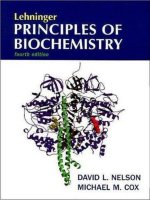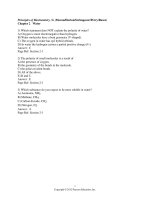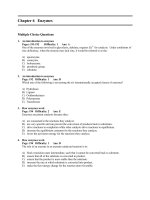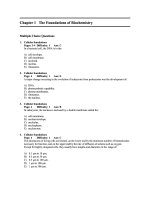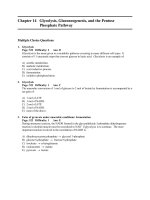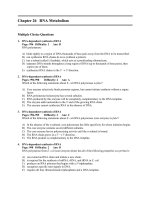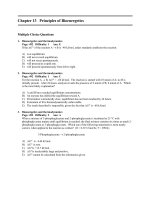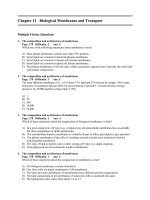lehninger principles of biochemistry test bank ch 19pdf
Bạn đang xem bản rút gọn của tài liệu. Xem và tải ngay bản đầy đủ của tài liệu tại đây (251.02 KB, 18 trang )
Chapter 19 Oxidative Phosphorylation and Photophosphorylation
Multiple Choice Questions
1. Electron-transfer reactions in mitochondria
Page: 690 Difficulty: 1 Ans: E
Almost all of the oxygen (O2) one consumes in breathing is converted to:
A)
B)
C)
D)
E)
acetyl-CoA.
carbon dioxide (CO2).
carbon monoxide and then to carbon dioxide.
none of the above.
water.
2. Electron-transfer reactions in mitochondria
Pages: 693-696
Difficulty: 3 Ans: E
A new compound isolated from mitochondria is claimed to represent a previously unrecognized
carrier in the electron transfer chain. It is given the name coenzyme Z. Which line of evidence do
you feel is the least conclusive in assigning this compound a position in the electron transfer chain?
A) Alternate oxidation and reduction of the mitochondrion-bound coenzyme Z can be readily
demonstrated.
B) Removal of coenzyme Z from the mitochondria results in a decreased rate of oxygen
consumption.
C) The rate of oxidation and reduction of mitochondrion-bound coenzyme is of the same order of
magnitude as the overall rate of electron transfer in mitochondria as measured by oxygen
consumption.
D) The reduction potential of Z is between that of two compounds known to participate in the
electron transport chain
E) When added to a mitochondrial suspension, coenzyme Z is taken up very rapidly and specifically
by the mitochondria.
3. Electron-transfer reactions in mitochondria
Page: 696 Difficulty: 2 Ans: B
Antimycin A blocks electron transfer between cytochromes b and c1. If intact mitochondria were
incubated with antimycin A, excess NADH, and an adequate supply of O2, which of the following
would be found in the oxidized state?
A)
B)
C)
D)
E)
Coenzyme Q
Cytochrome a3
Cytochrome b
Cytochrome e
Cytochrome f
Chapter 19 Oxidative Phosphorylation and Photophosphorylation
221
4. Electron-transfer reactions in mitochondria
Page: 698 Difficulty: 2 Ans: B
Cyanide, oligomycin, and 2,4-dinitrophenol (DNP) are inhibitors of mitochondrial aerobic
phosphorylation. Which of the following statements correctly describes the mode of action of the
three inhibitors?
A) Cyanide and 2,4-dinitrophenol inhibit the respiratory chain, and oligomycin inhibits the
synthesis of ATP.
B) Cyanide inhibits the respiratory chain, whereas oligomycin and 2,4-dinitrophenol inhibit the
synthesis of ATP.
C) Cyanide, oligomycin, and 2,4-dinitrophenol compete with O2 for cytochrome oxidase (Complex
IV).
D) Oligomycin and cyanide inhibit synthesis of ATP; 2,4-dinitrophenol inhibits the respiratory
chain.
E) Oligomycin inhibits the respiratory chain, whereas cyanide and 2,4-dinitrophenol prevent the
synthesis of ATP.
5. Electron-transfer reactions in mitochondria
Page: 700 Difficulty: 2 Ans: B
In the reoxidation of QH2 by purified ubiquinone-cytochrome c reductase (Complex III) from heart
muscle, the overall stoichiometry of the reaction requires 2 mol of cytochrome c per mole of QH2
because:
A) cytochrome c is a one-electron acceptor, whereas QH2 is a two-electron donor.
B) cytochrome c is a two-electron acceptor, whereas QH2 is a one-electron donor.
C) cytochrome c is water soluble and operates between the inner and outer mitochondrial
membranes
D) heart muscle has a high rate of oxidative metabolism, and therefore requires twice as much
cytochrome c as QH2 for electron transfer to proceed normally.
E) two molecules of cytochrome c must first combine physically before they are catalytically active.
6. ATP synthesis
Page: 696 Difficulty: 3 Ans: A
If electron transfer in tightly coupled mitochondria is blocked (with antimycin A) between
cytochrome b and cytochrome c1, then:
A)
B)
C)
D)
E)
all ATP synthesis will stop.
ATP synthesis will continue, but the P/O ratio will drop to one.
electron transfer from NADH will cease, but O2 uptake will continue.
electron transfer from succinate to O2 will continue unabated.
energy diverted from the cytochromes will be used to make ATP, and the P/O ratio will rise.
222
Chapter 19 Oxidative Phosphorylation and Photophosphorylation
7. ATP synthesis
Pages: 704-707
Difficulty: 3 Ans: E
In normal mitochondria, the rate of NADH consumption (oxidation) will:
A)
B)
C)
D)
E)
be increased in active muscle, decreased in inactive muscle.
be very low if the ATP synthase is inhibited, but increase when an uncoupler is added.
decrease if mitochondrial ADP is depleted.
decrease when cyanide is used to prevent electron transfer through the cytochrome a + a3
complex.
All of the above are true.
8. ATP synthesis
Page: 704 Difficulty: 2 Ans: A
Which of the following statements about the chemiosmotic theory is correct?
A) Electron transfer in mitochondria is accompanied by an asymmetric release of protons on one
side of the inner mitochondrial membrane.
B) It predicts that oxidative phosphorylation can occur even in the absence of an intact inner
mitochondrial membrance.
C) The effect of uncoupling reagents is a consequence of their ability to carry electrons through
membranes.
D) The membrane ATP synthase has no significant role in the chemiosmotic theory.
E) All of the above are correct.
9. ATP synthesis
Page: 705 Difficulty:1
Ans: E
Which of the following statements about the chemiosmotic theory is false?
A) Electron transfer in mitochondria is accompanied by an asymmetric release of protons on one
side of the inner mitochondrial membrane.
B) Energy is conserved as a transmembrane pH gradient.
C) Oxidative phosphorylation cannot occur in membrane-free preparations.
D) The effect of uncoupling reagents is a consequence of their ability to carry protons through
membranes.
E) The membrane ATPase, which plays an important role in other hypotheses for energy coupling,
has no significant role in the chemiosmotic theory.
10. ATP synthesis
Page: 705 Difficulty: 3 Ans: A
Upon the addition of 2,4-dinitrophenol (DNP) to a suspension of mitochondria carrying out oxidative
phosphorylation linked to the oxidation of malate, all of the following occur except:
A)
B)
C)
D)
E)
oxygen consumption decreases.
oxygen consumption increases.
the P/O ratio drops from a value of approximately 2.5 to 0.
the proton gradient dissipates.
the rate of transport of electrons from NADH to O2 becomes maximal.
Chapter 19 Oxidative Phosphorylation and Photophosphorylation
223
11. ATP synthesis
Page: 707 Difficulty: 1 Ans: C
Uncoupling of mitochondrial oxidative phosphorylation:
A)
B)
C)
D)
E)
allows continued mitochondrial ATP formation, but halts O2 consumption.
halts all mitochondrial metabolism.
halts mitochondrial ATP formation, but allows continued O2 consumption.
slows down the citric acid cycle.
slows the conversion of glucose to pyruvate by glycolysis.
12. ATP synthesis
Page: 707 Difficulty: 2 Ans: A
2,4-Dinitrophenol and oligomycin inhibit mitochondrial oxidative phosphorylation. 2,4Dinitrophenol is an uncoupling agent; oligomycin blocks the ATP synthesis reaction itself.
Therefore, 2,4-dinitrophenol will:
A)
B)
C)
D)
E)
allow electron transfer in the presence of oligomycin.
allow oxidative phosphorylation in the presence of oligomycin.
block electron transfer in the presence of oligomycin.
diminish O2 consumption in the presence of oligomycin
do none of the above.
13. ATP synthesis
Page: 707 Difficulty: 1 Ans: D
Which of the following statements about energy conservation in the mitochondrion is false?
A) Drug that inhibits the ATP synthase will also inhibit the flow of electrons down the chain of
carriers.
B) For oxidative phosphorylation to occur, it is essential to have a closed membranous structure
with an inside and an outside.
C) The yield of ATP per mole of oxidizable substrate depends on the substrate.
D) Uncouplers (such as dinitrophenol) have exactly the same effect on electron transfer as inhibitors
such as cyanide; both block further electron transfer to oxygen.
E) Uncouplers “short circuit” the proton gradient, thereby dissipating the proton motive force as
heat.
14. ATP synthesis
Page: 708 Difficulty: 2 Ans: E
Which of the following is correct concerning the mitochondrial ATP synthase?
A)
B)
C)
D)
E)
It can synthesize ATP after it is extracted from broken mitochondria.
It catalyzes the formation of ATP even though the reaction has a large positive ∆G'°.
It consists of F0 and F1 subunits, which are transmembrane (integral) polypeptides.
It is actually an ATPase and only catalyzes the hydrolysis of ATP.
When it catalyzes the ATP synthesis reaction, the ∆G'° is actually close to zero.
224
Chapter 19 Oxidative Phosphorylation and Photophosphorylation
15. ATP synthesis
Page: 709 Difficulty: 2 Ans: D
When the ∆G'° of the ATP synthesis reaction is measured on the surface of the ATP synthase
enzyme, it is found to be close to zero. This is thought to be due to:
A)
B)
C)
D)
E)
a very low energy of activation.
enzyme-induced oxygen exchange.
stabilization of ADP relative to ATP by enzyme binding.
stabilization of ATP relative to ADP by enzyme binding.
none of the above.
16. ATP synthesis
Page: 712 Difficulty: 2 Ans: C
During oxidative phosphorylation, the proton motive force that is generated by electron transport is
used to:
A)
B)
C)
D)
E)
create a pore in the inner mitochondrial membrane.
generate the substrates (ADP and Pi) for the ATP synthase.
induce a conformational change in the ATP synthase.
+
oxidize NADH to NAD .
reduce O2 to H2O.
17. ATP synthesis
Page: 713 Difficulty: 2 Ans: C
The oxidation of a particular hydroxy substrate to a keto product by mitochondria has a P/O ratio of
less than 2. The initial oxidation step is very likely directly coupled to the:
A)
B)
C)
D)
E)
oxidation of a flavoprotein.
oxidation of a pyridine nucleotide.
reduction of a flavoprotein.
reduction of a pyridine nucleotide.
reduction of cytochrome a3.
18. General features of photophosphorylation
Page: 724 Difficulty: 2 Ans: B
Which of the following statements about the light reactions in photosynthetic plants is false?
A)
B)
C)
D)
E)
A membrane-bound ATPase couples ATP synthesis to electron transfer.
No CO2 is fixed in the light reactions.
The ultimate electron acceptor is O2.
The ultimate source of electrons for the process is H2O.
There are two distinct photosystems, linked together by an electron transfer chain.
Chapter 19 Oxidative Phosphorylation and Photophosphorylation
19. General features of photophosphorylation
Page: 724 Difficulty: 1 Ans: D
The light reactions in photosynthetic higher plants:
A)
B)
C)
D)
E)
do not require chlorophyll.
produce ATP and consume NADH.
require the action of a single reaction center.
result in the splitting of H2O, yielding O2.
serve to produce light so that plants can see underground.
20. General features of photophosphorylation
Page: 724 Difficulty: 2 Ans: C
Photosynthetic phosphorylation and oxidative phosphorylation appear to be generally similar
processes, both consisting of ATP synthesis coupled to the transfer of electrons along an electron
carrier chain. Which of the following is not true of both processes?
A)
B)
C)
D)
E)
Both contain cytochromes and flavins in their electron carrier chains.
Both processes are associated with membranous elements of the cell.
Both use oxygen as a terminal electron acceptor.
Each represents the major route of ATP synthesis in those cells in which it is found.
Protons are pumped from the inside to the outside of both mitochondria and chloroplast
membranes
21. Regulation of oxidative phosphorylation
Page: 718 Difficulty: 2 Ans: E
The relative concentrations of ATP and ADP control the cellular rates of:
A)
B)
C)
D)
E)
glycolysis.
oxidative phosphorylation.
pyruvate oxidation.
the citric acid cycle.
all of the above.
22. Regulation of oxidative phosphorylation
Page: 718 Difficulty: 2 Ans: D
The rate of oxidative phosphorylation in mitochondria is controlled primarily by:
A)
B)
C)
D)
E)
feedback inhibition by CO2.
the availability of NADH from the TCA cycle.
the concentration of citrate (or) the glycerol-3-phosphate shuttle.
the mass-action ratio of the ATD-ADP system.
the presence of thermogenin.
225
226
Chapter 19 Oxidative Phosphorylation and Photophosphorylation
23. Mitochondrial genes: their origin and the effects of mutation
Page: 719 Difficulty: 2 Ans: B
Mutations in mitochondrial genes play a role in each of the following diseases except:
A)
B)
C)
D)
E)
adult onset diabetes.
cystic fibrosis.
hypertrophic cardiomyopathy.
Leber’s hereditary optic neuropathy.
myoclonic epilepsy.
24. Mitochondrial genes: their origin and the effects of mutation
Page: 719 Difficulty: 2 Ans: A
Which one of the following statements about human mitochondria is true?
A)
B)
C)
D)
E)
About 900 mitochondrial proteins are encoded by nuclear genes.
Mitochondrial genes are inherited from both maternal and paternal sources.
rRNA and tRNA are imported from the cytoplasm and used in mitochondrial protein synthesis.
The mitochondrial genome codes for all proteins found in mitochondria.
The mitochondrial genome is not subject to mutations.
25. Mitochondria play key roles in apoptosis and oxidative stress
Page: 721 Difficulty: 2 Ans: E
Which one of the following best describes the role of mitochondria in apoptosis?
A)
B)
C)
D)
E)
Escape of cytochrome c into the cytoplasm.
Increased rate of fatty acid β-oxidation.
Increase in permeability of outer membrane.
Uncoupling of oxidative phosphorylation.
Both A and C are correct.
26. Light absorption
Page: 723 Difficulty: 2 Ans: A
In photophosphorylation, absorption of light energy in chloroplast “light reactions” leads to:
A)
B)
C)
D)
E)
absorption of CO2 and release of O2.
absorption of O2 and release of CO2.
hydrolysis of ATP and reduction of NADP+.
synthesis of ATP and oxidation of NADPH.
use of iron-sulfur proteins.
27. Light absorption
Page: 725 Difficulty: 2 Ans: A
Oxidative phosphorylation and photophosphorylation share all of the following except:
A)
B)
C)
D)
E)
chlorophyll.
involvement of cytochromes.
participation of quinones.
proton pumping across a membrane to create electrochemical potential.
use of iron-sulfur proteins.
Chapter 19 Oxidative Phosphorylation and Photophosphorylation
227
28. Light absorption
Page: 728 Difficulty: 2 Ans: B
The experimental determination of the effectiveness of light of different colors in promoting
photosynthesis is called the:
A) absorption spectrum.
B) action spectrum.
C) difference spectrum.
D) reflectance spectrum.
E) refraction spectrum.
29. Light absorption
Pages: 728-729
Difficulty: 2 Ans: C
In what order do the following five steps occur in the photochemical reaction centers?
1)
2)
3)
4)
5)
A)
B)
C)
D)
E)
Excitation of the chlorophyll a molecule at the reaction center
Replacement of the electron in the reaction center chlorophyll
Light excitation of antenna chlorophyll molecule
Passage of excited electron to electron-transfer chain
Exiton transfer to neighboring chlorophyll
1-2-3-4-5
3-2-5-4-1
3-5-1-4-2
4-2-3-5-1
5-4-3-2-1
30. The central photochemical event: light-driven electron flow
Pages: 733-738
Difficulty: 3 Ans: A
Which one of the following is true about reaction centers?
A)
B)
C)
D)
E)
Cyanobacteria and plants have two reaction centers arranged in tandem.
Cyanobacteria contain a single reaction center of the Fe-S type.
Green sulfur bacteria have two reaction centers arranged in tandem.
Plant photosystems have a single reaction center of the pheophytin-quinone type.
Purple bacteria contain a single reaction center of the Fe-S type.
31. The central photochemical event: light-driven electron flow
Page: 734 Difficulty: 3 Ans: C
In the photolytic cleavage of water by the oxygen-evolving complex [2H2O → 4 H+ + 4e– + O2], how
many photons of light at a wavelength of 680 nm are required?
A)
B)
C)
D)
E)
1
2
4
6
8
228
Chapter 19 Oxidative Phosphorylation and Photophosphorylation
32. ATP synthesis by photophosphorylation
Page: 741 Difficulty: 3 Ans: C
Which one of the following statements about photophosphorylation is false?
A) It can be uncoupled from electron flow by agents that dissipate the proton gradient.
B) The difference in pH between the luminal and stromal side of the thylakoid membrane is 3 pH
units.
C) The luminal side of the thylakoid membrane has a higher pH than the stromal side.
D) The number of ATPs formed per oxygen molecule is about three.
E) The reaction centers, electron carriers, and ATP-forming enzymes are located in the thylakoid
membrane.
33. ATP synthesis by photophosphorylation
Page: 741 Difficulty: 3 Ans: B
Cyclic electron flow in chloroplasts produces:
A)
B)
C)
D)
E)
ATP and O2, but not NADPH.
ATP, but not NADPH or O2 .
NADPH, and ATP, but not O2 .
NADPH, but not ATP or O2 .
O2, but not ATP or NADPH.
Short Answer Questions
34. Electron-transfer reactions in mitochondria
Page: 696 Difficulty: 1
As you read and answer this question, you are (presumably) consuming oxygen. What single reaction
accounts for most of your oxygen consumption?
Ans: O2 is converted to H2O by electrons from the respiratory chain. The final step is the one
catalyzed by cytochrome oxidase (Complex IV).
35. Electron-transfer reactions in mitochondria
Page: 696 Difficulty: 3
Show the path of electrons from ubiquinone (Q or coenzyme Q) to oxygen in the mitochondrial
respiratory chain. One of the two compounds (Q and O2) has a standard reduction potential (E'°) of
0.82 V, and the other, 0.045 V. Which value belongs to each compound? How did you deduce this?
Ans: QH2 → cyt b → cyt c1 → cyt c → cyt (a + a3) → O2
E'° for O2 must be the larger positive value (+0.82) because electron flow occurs spontaneously to the
electron acceptor with the more positive E'°.
36. Electron-transfer reactions in mitochondria
Pages: 696-701
Difficulty: 3
Diagram the path of electron flow from NADH to the final electron acceptor during electron transport
in mitochondria. For each electron carrier, indicate whether only electrons, or both electrons and
protons, are accepted/donated by that carrier. Indicate with an arrow where electrons from succinate
oxidation enter the chain of carriers.
Chapter 19 Oxidative Phosphorylation and Photophosphorylation
229
Ans: NADH (both) → FP (both) → Q (both) → cyt b (e– only) → cyt c1 (e– only) → cyt c (e– only)
→ cyt (a + a3) (e– only) → O2 (both)
Electrons from succinate enter at Q.
37. Electron-transfer reactions in mitochondria
Pages: 695, 701
Difficulty: 3
A recently discovered bacterium carries out ATP synthesis coupled to the flow of electrons through a
chain of carriers to some electron acceptor. The components of its electron transfer chain differ from
those found in mitochondria; they are listed below with their standard reduction potentials.
Electron carriers in the newly discovered bacterium:
—————————————————————————————————————
Electrons
E'°
Oxidant
Reductant
transferred
(V)
—————————————————————————————————————
+
NAD NADH
2 –0.32
flavoprotein b (FPb)
flavoprotein b
2
–0.62
(oxidized)
(reduced)
3+
2+
cytochrome c (Fe )
cytochrome c (Fe )
1
+0.22
Fe-S protein
Fe-S protein
2
+0.89
(oxidized)
(reduced)
flavoprotein a (FPa)
flavoprotein a
2
+0.77
(oxidized)
(reduced)
—————————————————————————————————————
(a) Place the electron carriers in the order in which they are most likely to act in carrying electrons.
(b) Is it likely that O2 (for which E'° = 0.82 V) is the final electron acceptor in this organism? Why or
why not? (c) How would you calculate the maximum number of ATP molecules that could
theoretically be synthesized, under standard conditions, per pair of electrons transfered through this
chain of carriers? (The Faraday constant, ℑ, is 96.48 kJ/V·mol.) ∆G'° for ATP synthesis is +30.5
kJ/mol.
(a) FPb→ NAD+ → cyt c → FPa → Fe-S
(b) No; Fe-S has a larger E'°, so will probably be the terminal acceptor.
(c) First calculate ∆G'° for e– flow from FPb to Fe-S:
∆E'° = E'°(oxidant) – E'°(reductant) = +0.89 – (–0.62) = +1.51 V
∆G'° = –nℑ∆E'° = (–2)(96.48 kJ/V·mol)(1.51 V) = –291 kJ/2e–
Theoretically, the flow of two electrons from FPb to Fe-S could drive the synthesis of 291 kJ/30.5
kJ/mol = 9.5 mol ATP. Because only whole numbers of molecules can be made, the correct answer is
9 mol ATP per electron pair.
Ans:
38. Electron-transfer reactions in mitochondria
Page: 701 Difficulty: 2
During electron transfer through the mitochondrial respiratory chain, the overall reaction is:
NADH + 1/2 O2 + H+ → NAD+ + H2O. The difference in reduction potentials for the two halfreactions (∆E'°) is +1.14 V. Show how you would calculate the standard free-energy change, ∆G'°,
for the reaction as written above. (The Faraday constant, ℑ, is 96.48 kJ/V·mol.)
Ans: ∆G'° = –nℑ∆E'° = (–2)(96.48 kJ/V·mol)(1.14V) = –220 kJ/mol
230
Chapter 19 Oxidative Phosphorylation and Photophosphorylation
39. Electron-transfer reactions in mitochondria
Page: 701 Difficulty: 3
The standard reduction potential for ubiquinone (Q or coenzyme Q) is 0.045 V, and the standard
reduction potential (E'°) for FAD is –0.219 V. Using these values, show that the oxidation of FADH2
by ubiquinone theoretically liberates enough energy to drive the synthesis of ATP. The Faraday
constant, ℑ, is 96.48 kJ/V·mol. ∆G'° for ATP synthesis is +30.5 kJ/mol.
Ans: ∆E'° = E'°(oxidant) – E'°(reductant) = 0.045 – (–0.219) = +0.264 V
∆G'° = –n ℑ∆E'° = (–2)(96.48 kJ/V.mol)(0.264 V) = –51.0 kJ/mol.
Passage of two electrons from FADH2 to Q can, in principle, provide sufficient energy for
synthesizing 1 ATP.
40. ATP synthesis
Pages: 704-705
Difficulty: 2
Describe, in simple diagrams and a few words, the chemiosmotic theory for coupling oxidation to
phosphorylation in mitochondria.
Ans: There are three central elements in the chemiosmotic model:
(1) Electron flow through asymmetrically arranged membrane-bound carriers causes transmembrane
flow of H+, creating a proton gradient (a proton motive force).
(2) The proton motive force drives protons back across the membrane via specific proton channels
(composed of Fo).
(3) The energy released by “downhill” movement of protons is captured when ADP and Pi are
condensed by ATP synthase (FoF1). (See Fig. 19-17, p. 705.)
41. ATP synthesis
Pages: 705, 707
Difficulty: 3
Compound X is an inhibitor of mitochondrial ATP synthesis. It was observed that when compound X
was added to cells, the NAD+/NADH ratio decreased. Would you expect X to be an uncoupling agent
or an inhibitor of respiratory electron transfer? Explain in 30 words or less.
Ans: It is an inhibitor of electron transfer; its addition lowers the NAD+/NADH ratio because NADH
produced by oxidative reactions in mitochondria can no longer be reoxidized by electron flow to O2.
42. ATP synthesis
Page: 705 Difficulty: 3
Cyanide ion (CN–) blocks electron transfer in mitochondria at the level of cytochrome a + a3. 2,4Dinitrophenol (DNP) is a potent uncoupler of mitochondrial oxidative phosphorylation. Add labeled
curves to the graphs below to show the effects of adding each of these compounds separately to a
suspension of mitochondria supplied with O2, succinate, ADP, and Pi. Arrow: time of drug addition.
Chapter 19 Oxidative Phosphorylation and Photophosphorylation
231
Ans:
43. ATP synthesis
Pages: 705, 707
Difficulty: 1
Give an example of (a) an uncoupler of oxidative phosphorylation, and (b) an inhibitor of respiration.
(c) Describe the difference in the effects of such uncouplers and inhibitors on mitochondrial function.
Ans: (a) Uncouplers include DNP, valinomycin, and CCCP. (b) Respiration inhibitors include
antimycin A, piericidin A, CN–, rotenone, and amytal. (c) Uncouplers stop formation of ATP while
allowing electron transfer to continue. Inhibitors of respiration block both electron transfer and
phosphorylation.
44. ATP synthesis
Pages: 705-707
Difficulty: 2
Mitochondria carrying out oxidative phosphorylation consume oxygen. Explain what happens to this
oxygen, and describe the effect of an uncoupling agent such as 2,4-dinitrophenol on the rate of
oxygen consumption. Assume there is a sufficient supply of oxidizable substrate, ADP, and Pi.
Ans: O2 is reduced to H2O by electrons passed through the respiratory chain. Addition of 2,4dinitrophenol, which uncouples phosphorylation (ATP synthesis) from electron flow, actually
stimulates O2 consumption slightly by removing the “drag” of ATP synthesis.
45. ATP synthesis
Page: 706 Difficulty: 2
The skunk cabbage (Symphocarpus foetidus) can maintain a temperature of 10–25 °C higher than the
temperature of the surrounding air. Suggest a mechanism for this.
Ans: One possible heat-generating mechanism is partially uncoupled mitochondria in which some of
the energy of electron flow is dissipated as heat.
46. ATP synthesis
Page: 708 Difficulty: 2
When the F1 portion of the ATP synthetase complex is removed from the mitochondrial membrane
and studied in solution, it functions as an ATPase. Why does it not function as an ATP synthetase?
Ans: Like all enzymes, the F1 subunit of the ATP synthase catalyzes a reaction in both directions:
ADP + Pi ↔ ATP + H2O
The standard free-energy change (∆G'°) for ATP hydrolysis is –30.5 kJ/mol. With no proton motive
force to drive the reaction toward ATP synthesis, the hydrolysis (ATPase activity) occurs
232
Chapter 19 Oxidative Phosphorylation and Photophosphorylation
spontaneously.
47. ATP synthesis
Pages: 705-717
Difficulty: 3
Using a simple diagram of the chemiosmotic theory, explain why anything that makes the
mitochondrial membrane leaky stops ATP synthesis in the mitochondria.
Ans: There are three central elements in the chemiosmotic model:
(1) Electron flow through asymmetrically arranged membrane-bound carriers causes transmembrane
+
flow of H , creating a proton gradient (a proton motive force).
(2) The proton motive force drives protons back across the membrane via specific proton channels
(composed of Fo).
(3) The energy released by downhill movement of protons is captured when ADP and Pi are
condensed by ATP synthase (FoF1). Anything that makes the membrane leaky to protons (an
uncoupler such as 2,4-dinitrophenol, or mechanical breakage of the membrane) prevents formation of
a proton gradient. With no proton gradient, there is no energy source for ATP synthesis by FoF1
(ATP synthase). (See Fig. 19-17, p. 705, and Fig. 19-30, p. 717.)
48. ATP synthesis
Page: 709 Difficulty: 2
When the ∆G'° of the ATP synthesis reaction is measured on the surface of the ATP synthase
enzyme, it was found to be close to zero. Describe briefly why this is so.
Ans: The enzyme binds ATP more tightly than ADP thus stabilizing the former (i.e., the product of
the synthesis reaction) relative to the latter (i.e., the reactant in the synthesis reaction).
49. ATP synthesis
Pages: 709-712
Difficulty: 3
Explain briefly the current model for how the proton motive force that is generated by electron
transport is used to drive the ATP synthesis reaction.
Ans: The tight binding of ATP by the enzyme stabilizes it and makes the ∆G'° of the synthetic
reaction more favorable. Once the reaction has occurred, the ATP product must be released from the
enzyme. The proton motive force causes protons to move across the inner mitochondrial membrane
through the pore in the Fo complex. This movement leads to conformational changes that decrease
the affinity of the F1 portion of the synthase for ATP, resulting in its release from the enzyme.
50. Regulation of oxidative phosphorylation
Pages: 716-718
Difficulty: 2
Describe and explain how each of the following manipulations will affect (1) the rate of NADH
consumption and (2) the rate of ATP synthesis in mitochondria.
(a) Depletion of ADP
(b) Addition of an uncoupler
(c) Addition of cyanide (CN–)
Ans:
NADH consumption
ATP synthesis
——————————————————————————
deplete ADP
lower
lower
add uncoupler
higher, or no change
lower
Chapter 19 Oxidative Phosphorylation and Photophosphorylation
233
add CN–
lower
lower
51. Regulation of oxidative phosphorylation
Page: 716 Difficulty: 2
What is respiratory control in mitochondria? What is accomplished by this control mechanism?
Ans: Respiratory control is the regulation of electron flow and ATP synthesis by [ADP]. When
[ADP] is low, electron flow slows; when [ADP] is high, electron flow is stimulated. The overall
effect is to keep the level of ATP nearly constant and to prevent oxidation of fuels when the demand
for ATP is low.
52. Regulation of oxidative phosphorylation
Pages: 716, 705
Difficulty: 3
In his studies of alcoholic fermentation by yeast, Louis Pasteur noted that the sudden addition of
oxygen (O2) to a previously anaerobic culture of fermenting grape juice resulted in a dramatic
decrease in the rate of glucose consumption. This “Pasteur effect” can be counteracted by the
addition of 2,4-dinitrophenol (DNP), an uncoupler of oxidative phosphorylation. (a) Why would the
yeast cells consume less glucose in the presence of oxygen? Can you estimate how much less glucose
they would use? (b) Why would DNP counteract or prevent the Pasteur effect?
Ans: (a) During aerobic oxidation of glucose, the yield of ATP is about 38 mol per mole of glucose.
Under anaerobic conditions, only 2 ATP are produced per glucose. Thus, to get the same amount of
ATP, a cell needs to use 19 times more glucose anaerobically.
(b) Because DNP blocks the principal path of aerobic ATP production, aerobic cells in the presence
of DNP need about the same amount of glucose as anaerobic cells.
53. Regulation of oxidative phosphorylation
Page: 717 Difficulty: 3
The compound 2,4-dinitrophenol (DNP), an uncoupler, was briefly used as a weight-loss drug. Some
of its effects in people who took the drug included weight loss and higher than normal body
temperature. Some people even died. Explain the first two effects of the compound in biochemical
terms.
Ans: The uncoupler allows continuous oxidation of fuels (like fatty acids from adipose tissue).
Because little or no ATP synthesis occurs, the respiratory control that normally limits fuel oxidation
when ATP levels are high does not operate. The energy of fuel oxidation is dissipated as heat,
accounting for the elevated body temperature.
54. Regulation of oxidative phosphorylation
Page: 718 Difficulty: 3
Although molecular oxygen (O2) does not participate directly in any of the reactions of the citric acid
cycle, the cycle operates only when O2 is present. Explain this observation.
Ans: The citric acid cycle produces NADH, which is normally reoxidized to NAD+ by the passage of
electrons through the respiratory chain to O2. With no O2 to accept electrons, NADH accumulates,
+
+
NAD is depleted, and the citric acid cycle slows for lack of NAD .
55. Regulation of oxidative phosphorylation
Page: 718 Difficulty: 3
Consider a liver cell carrying out the oxidation of glucose under aerobic conditions. Suppose that we
added a very potent and specific inhibitor of the mitochondrial ATP synthase, completely inhibiting
234
Chapter 19 Oxidative Phosphorylation and Photophosphorylation
this enzyme. Indicate whether each of the following statements about the effect of this inhibitor is
true or false; if false, explain in a sentence or two why it is false.
____ (a) ATP production in the cell will quickly drop to zero.
____ (b) The rate of glucose consumption by this cell will decrease sharply.
____ (c) The rate of oxygen consumption will increase.
____ (d) The citric acid cycle will speed up to compensate.
____ (e) The cell will switch to fatty acid oxidation as an alternative to glucose oxidation, and the
inhibitor will therefore have no effect on ATP production.
Ans: (a) False. Mitochondrial ATP synthesis will cease, but to compensate, cells will accelerate the
production of ATP by glycolysis, preventing ATP levels from dropping to zero.
(b) False. The acceleration of glycolysis noted above will actually increase the rate of glucose
consumption.
(c) False. Because electron transfer through the respiratory chain is tightly coupled to ATP synthesis,
blocking ATP synthase blocks electron flow and oxygen consumption.
(d) False. The citric acid cycle is an oxidative pathway, producing NADH. When electron flow from
+
NADH to O2 is blocked, NADH accumulates, NAD is depleted, and the citric acid cycle slows for
+
lack of an electron acceptor (NAD ).
(e) False. Oxidation of fats produces NADH, FADH2, and acetyl-CoA, which is further oxidized via
the citric acid cycle. For the reasons noted above, blocking electron flow through the respiratory
chain prevents ATP synthesis with energy from fatty acid oxidation.
56. Mitochondrial genes: their origin and the effects of mutation
Page: 719 Difficulty: 2
Mutations in mitochondrial genes frequently produce diseases that affect the brain and skeletal
muscle (mitochondrial encephalomyopathies). Why are these two tissues particularly sensitive to
mitochondrial mutations?
Ans: Both the brain and skeletal muscles are heavily dependent on an abundant supply of ATP for
normal functioning.
57. Mitochondrial genes: their origin and the effects of mutation
Page: 721 Difficulty: 2
Discuss three lines of evidence that support the theory that mitochondria evolved from
endosymbiontic bacteria.
Ans: 1) Modern prokaryotes have respiratory chains very similar to those in mitochondria. 2)
Bacteria translate protons outward across their plasma membrane and use this proton gradient to drive
ATP synthesis and other energy-requiring processes such as flagellar motion. 3) Unlike most other
organelles, mitochondria in eukaryotic cells retain their own genome.
58. The role of mitochondria in apoptosis and oxidative stress
Pages: 721, 699
Difficulty: 2
Cytochrome c plays two distinct and very important roles in mammalian cells: (1) in the
mitochondrial electron transport chain, and (2) in apoptotic cell death. Describe the roles of
cytochrome c in these two processes.
Ans: In the electron transport chain, cytochrome c accepts electrons from complex III and transfers
them to complex IV. In the electron transport chain, cytochrome c is the only water soluble carrier.
It operates in the space between the outer and inner mitochondrial membranes. In apoptotic cell
Chapter 19 Oxidative Phosphorylation and Photophosphorylation
235
death, the permeability of the outer mitochondrial membrane increases dramatically allowing the
escape of cytochrome c into the cytoplasm where it activates caspase 9, one of the main proteolytic
enzymes active in apoptosis.
59. The role of mitochondria in apoptosis and oxidative stress
Page: 722 Difficulty: 2
Oxidative stress results when the superoxide anion (O2–) is formed as a side reaction of mitochondrial
electron transport. This oxygen anion radical is made nontoxic by the action of four enzymes of the
mitochondrial matrix. Name these four enzymes and briefly describe the role of each in detoxifying
the superoxide anion (O2-).
Ans: The enzymes are (1) superoxide dismutase, (2) glutathione peroxidase, (3) glutathione
reductase, and (4) nicotinamide nucleotide transhydrogenase. Superoxide dismutase acts on two O2–,
converting them to one molecule of water and one of H2O2. Next, glutathione peroxidase reduces the
H2O2 to two molecules of water with the concomitant oxidation of 2 glutathiones (GSH) to a
molecule of oxidized glutathione (GSSG). Glutathione reductase re-reduces the oxidized glutathione
with the conversion of NADPH to NADP+. In the final step, nicotinamide nucleotide
transhydrogenase replenishes the NADPH consumed in the glutathione reductase reaction using
reduced NADH as the electron donor.
60. General features of photophosphorylation
Pages: 723-724
Difficulty: 2
Photophosphorylation differs from oxidative phosphorylation in that the former requires the input of
energy in the form of ___________ to create a good electron donor. In photophosphorylation,
electrons flow through a series of membrane-bound carriers including ___________ , ___________ ,
and ___________ proteins, whereas ___________ are pumped across a membrane to create an
___________ potential.
Ans: Light, cytochromes, quinones, iron-sulfur, protons, electrochemical.
61. General features of photophosphorylation
Pages: 723-724
Difficulty: 2
Describe the effect(s) that a mitochondrial uncoupler such as 2,4-dinitrophenol (DNP) would have on
photophosphorylation.
Ans: Uncouplers like DNP, which act by dissipating transmembrane proton gradients, would
uncouple photophosphorylation because it is also dependent on a transmembrane proton gradient to
provide the energy required to synthesize ATP from ADP and Pi.
62. Light absorption
Page: 728 Difficulty: 2
Discuss how “accessory pigments” are able to extend the range of light absorption of the
chlorophylls. Name some accessory pigments.
Ans: Accessory pigments are able to absorb light and transfer the absorbed energy to the
chlorophylls in a process know as “exciton transfer.” Two accessory pigments are β-carotene and
lutein.
236
Chapter 19 Oxidative Phosphorylation and Photophosphorylation
63. Light absorption
Page: 728 Difficulty: 2
What is an action spectrum, and what do peaks in an action spectrum signify? Show a typical action
spectrum plot for photosynthesis.
Ans: An action spectrum is a plot of the effectiveness of a process (such as photosynthesis) versus
wavelength of incident light. Its peaks signify the presence of a chromophore that absorbs light at
that wavelength. (See Fig. 19-44, p. 728.)
64. The central photochemical event: light-driven electron flow
Pages: 729, 733
Difficulty: 2
Describe what happens at photosystem I from the point where an antenna chlorophyll molecule
absorbs a photon of light to the passage of an electron to NADP+.
Ans: The antenna chlorophyll molecule passes the energy of the photon, via exciton transfer, to
neighboring chlorophyll molecules and ultimately to reaction center chlorophyll molecules. This
excites P700 to P700*, which donates an electron to A0. From A0, electrons pass to phylloquinone
(A1), through an Fe-S protein, to ferredoxin, then through a flavoprotein to NADP+.
P700* → A0 → A1 → Fe-S → NADP+ (See Figs. 19-43, p. 698, and 19-46, p. 703.)
65. The central photochemical event: light-driven electron flow
Page: 731-738
Difficulty: 2
Give five general classes of electron carriers that function in both mitochondrial electron transfer to
O2 and photosynthetic electron transfer.
Ans: Any five of the following: pyridine nucleotides (NADH, NADPH); flavin nucleotides (FADH2,
FMNH2); quinones (ubiquinone, plastoquinone); cytochromes; Fe-S proteins; flavoproteins.
66. The central photochemical event: light-driven electron flow
Pages: 731-738
Difficulty: 3
The processes of oxidative phosphorylation coupled with electron transfer (in mitochondria) and
photophosphorylation (in chloroplasts) resemble each other in certain respects. Describe five ways in
which the two processes are similar, and describe three significant differences between the two
processes.
Ans: Similarities include: both contain a chain of membrane-bound electron carriers; electron transfer
leads to establishment of a proton gradient; an ATPase/ATP synthase is a coupling factor; ATP
synthesis is sensitive to uncouplers; both require a system of intact membranes to separate electrons
inside and outside. Differences include: source of reducing power (NADH vs. light), product (ATP in
respiration; NADPH in photosynthesis); source of oxidizing power (O2 in mitochondria; light in
photosynthesis).
67. The central photochemical event: light-driven electron flow
Page: 733 Difficulty: 2
Show the path of electrons from photosystem II to NADPH in the chloroplast. What is the source of
the energy that moves electrons through this path? Show where oxygen is involved in this pathway.
Chapter 19 Oxidative Phosphorylation and Photophosphorylation
237
Ans: H2O → P680 → Pheophytin → PQA → PQB → cyt b6f complex → Plastocyanin → P700 →
A0 → A1 → Fe-S → Ferredoxin → Ferredoxin-NADP+ oxidoreductase → NADP+.
The energy that drives the electron flow is from light. O2 is generated from H2O when H2O donates
electrons to PSII.
68. The central photochemical event: light-driven electron flow
Page: 733 Difficulty: 2
Plants carrying out photosynthesis produce O2. Describe the source of this O2, and explain, with
chemical equations or schematic diagrams, why O2 production occurs only during daylight hours.
Ans: O2 is generated by the splitting and oxidation of H2O, driven by the absorption of a photon by
PSII (which occurs only in daylight). (See Fig. 19-49, p. 733.)
69. The central photochemical event: light-driven electron flow
Page: 734 Difficulty: 2
During photophosphorylation in plants, electrons flow through a series of carriers in the chloroplast.
What is the ultimate donor of electrons, and what is the ultimate acceptor? What provides the energy
to move those electrons?
Ans: The ultimate donor is H2O, and the acceptor, NADP+. The energy that drives this electron flow
is from light.
70. The central photochemical event: light-driven electron flow
Page: 739 Difficulty: 3
Describe what happens when a photon is absorbed by photosystem II; end the description of electron
flow at plastoquinone.
Ans: Absorption of a photon by PSII excites P680 to P680*, which passes an electron to pheophytin,
which passes the electron to plastoquinone. P680, now lacking an electron, takes one away from a
“water-splitting complex” of PSII, which in turn takes one from H2O. (See Fig. 19-56, p. 739.)
71. ATP synthesis by photophosphorylation
Pages: 741-742
Difficulty: 3
DCMU is an herbicide that acts by blocking photosynthetic electron flow from photosystem II (PSII)
to the cytochrome b6f complex. Predict the effect of DCMU on O2 production and on ATP synthesis
in the chloroplasts of plants sensitive to DCMU.
Ans: DCMU blocks electron flow from PSII to PSI, preventing generation of O2 from H2O. ATP
synthesis will be inhibited, but not completely; cyclic photophosphorylation can continue in the
presence of DCMU.
